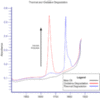I am investigating a case of hydraulic oil (SAE10) blackening on a substantial number of hydraulic excavators. Preliminary oil analysis showed that oil oxidation and deterioration is not the cause of blackening. I have read previous message board discussion on the Dark colored oil and and suspect that we may have a situation of micro-dieseling. Would appreciate if you could help me with the following questions:
1.What other method can we use to test if oil has undergone micro-dieseling in a hydraulic system?
2. What extent of micro-dieseling would need to turn a hydraulic system of 585Ltrs,tank+system capacity (175+410)into black condition?
3. Would using SAE30 or a 15W40 grade oil produce a different outcome?
4. Would present of goldish color on component in the hydraulic system indicate that micro-dieseling is happening at that component?
Original Post


